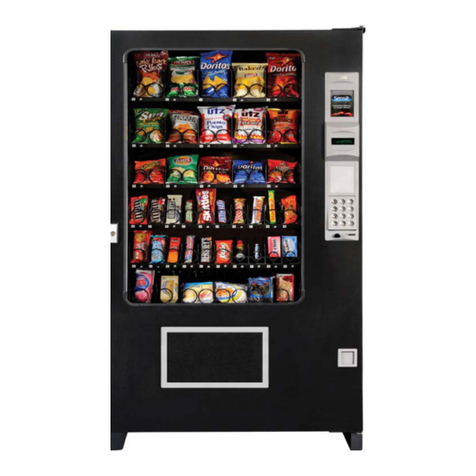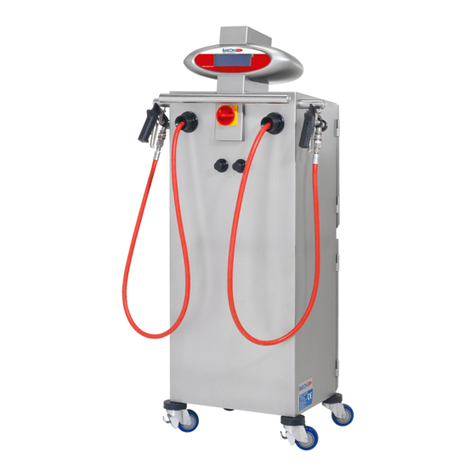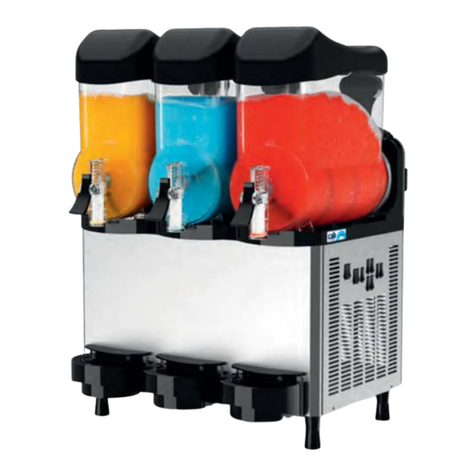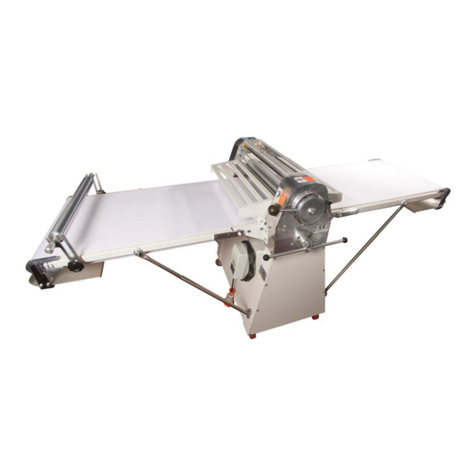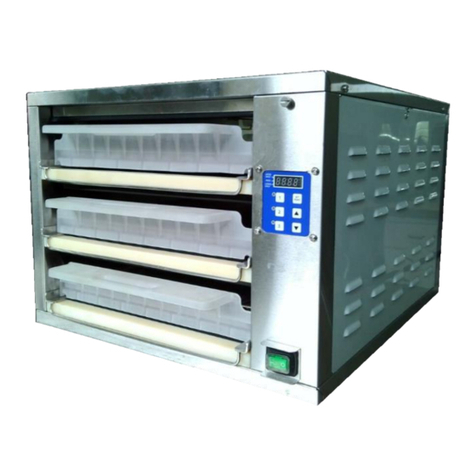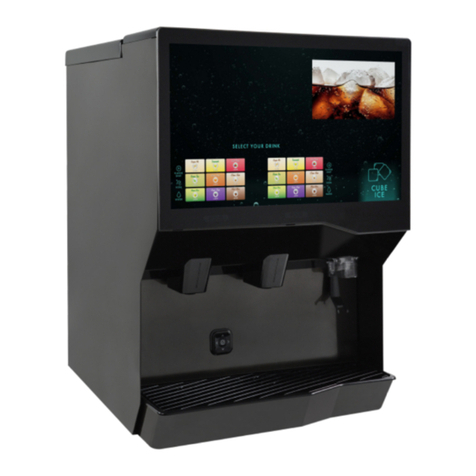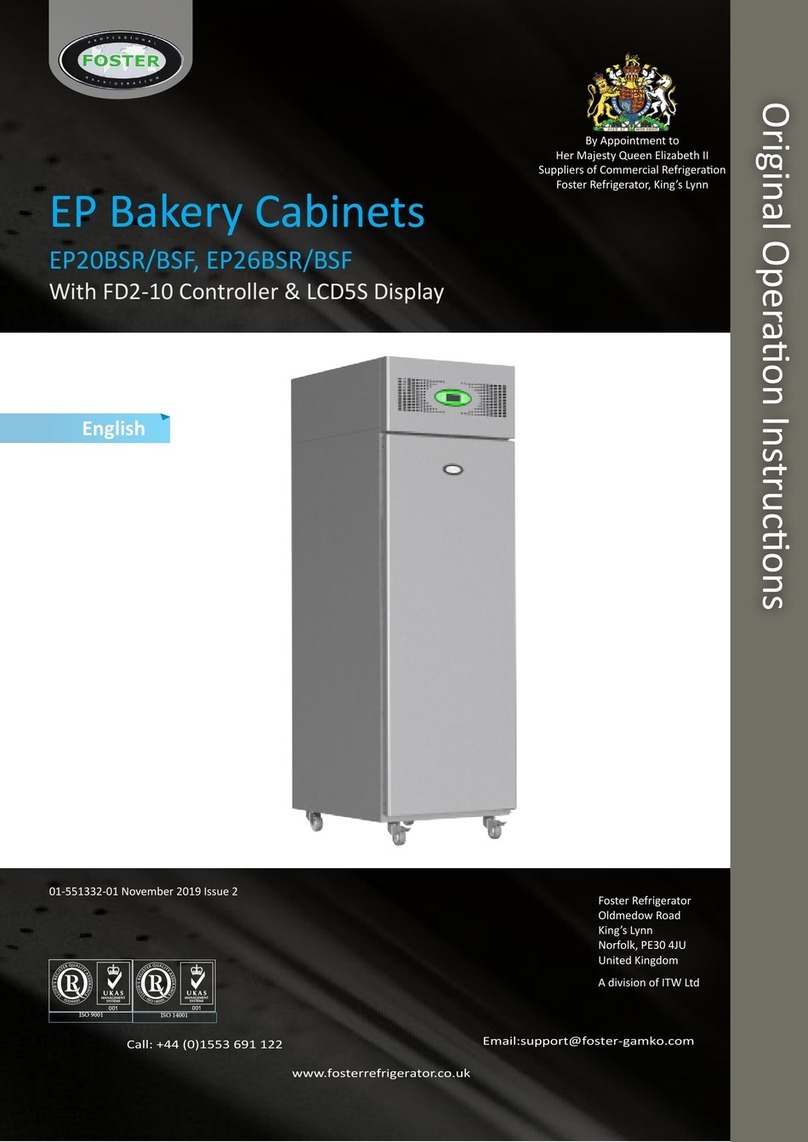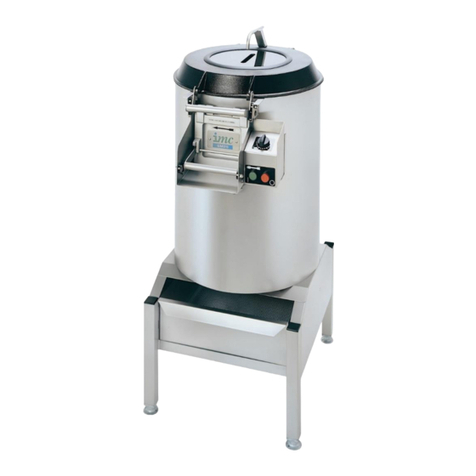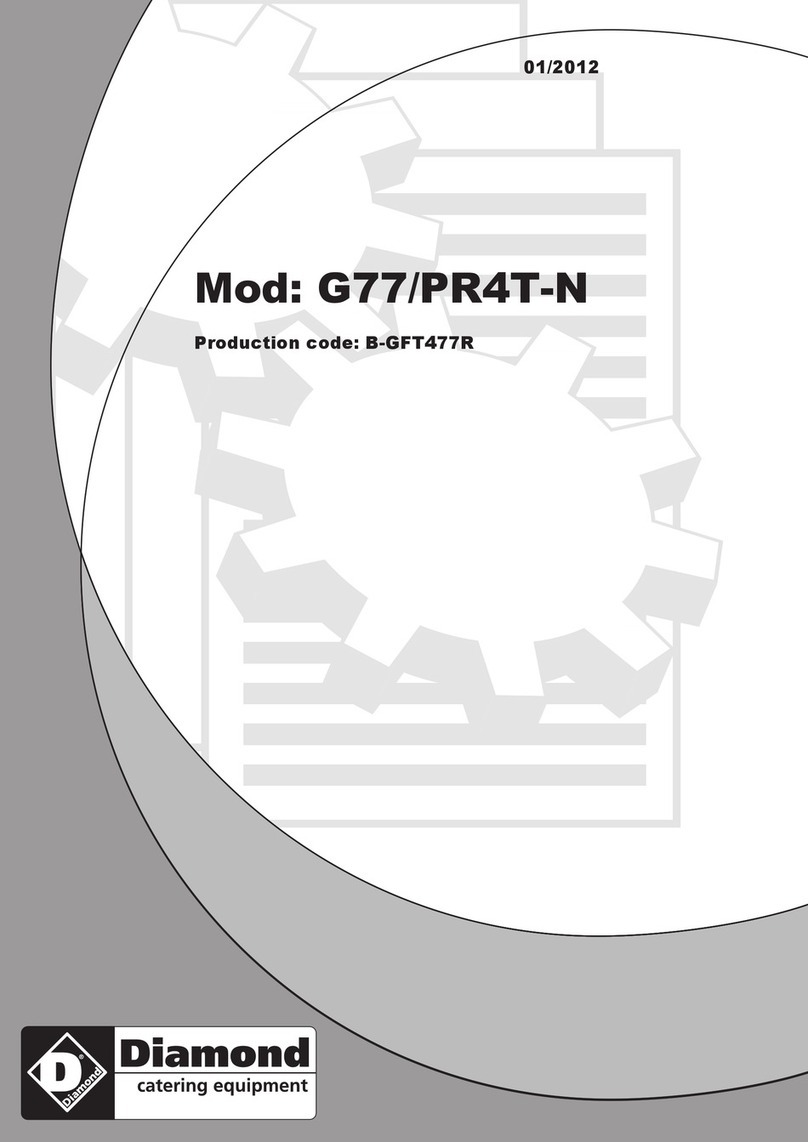Lincat BPSM7 User manual

IS791 ECN 4879 Page 1 of 34
Installation, Operating and Servicing
Instructions
REFIGERATED CABINETS AND WORK TABLES
BPSM7, BPSM14, BPSB7, BPSB14
BPETM2, BPETM3
Please make a note of your product details for
future use:
Date Purchased:_________________________
Model Number:__________________________
Serial Number:__________________________
Dealer:_________________________________
_______________________________________

IS791 ECN 4879 Page 2 of 34
CONTENTS
IMPORTANT INFORMATION........................................................................................................................................3
WARNINGS AND PRECAUTIONS...............................................................................................................................4
1.1 TESTING AND INTENDED USE.......................................................................................................................4
1.2 INTRODUCTION............................................................................................................................................4
1.3 PRODUCT DESCRIPTION.................................................................................................................................4
1.4 GENERAL SAFETY REGULATIONS ...............................................................................................................5
1.5 CUSTOMER’S RESPONSIBILITIES ................................................................................................................6
1.6 CUSTOMER SERVICE REQUESTS .................................................................................................................6
1.7 ORDERING OF SPARE PARTS........................................................................................................................6
1.8 PRODUCT CONFIGURATION ...........................................................................................................................6
1.9 MATERIALS AND REFRIGERANTS................................................................................................................6
1.10 WARNING LABELS..........................................................................................................................................6
TECHNICAL DATA........................................................................................................................................................10
INSTALLATION AND COMMISSIONING ..................................................................................................................11
2.1TRANSPORTATION AND HANDLING............................................................................................................11
2.2 POSITIONING ....................................................................................................................................................12
2.3 WIRING AND ELECTRICAL HOOK-UP..................................................................................................12
2.4SET UP OPERATIONS.......................................................................................................................................13
2.5RE- INSTALLATION............................................................................................................................................13
2.6SCRAPPING AND DISPOSAL..........................................................................................................................13
OPERATING INSTRUCTIONS....................................................................................................................................14
3.1 CONTROLLER GENERAL DESCRIPTION..................................................................................................14
3.1.1 REGULATION .............................................................................................................................................15
3.1.2 CONTROLLER USER INTERFACE AND MAIN FUNCTION...............................................................16
3.1.3 Switching the device ON/OFF....................................................................................................................17
3.1.4 “MACHINE STATUS" MENU......................................................................................................................17
3.1.5 MANUAL DEFROST CYCLE ACTIVATION ............................................................................................17
3.1.6DIAGNOSTICS..............................................................................................................................................17
3.1.7ALARMS.........................................................................................................................................................18
3.1.8CONTROLLER’S INPUT/OUTPUT ............................................................................................................19
3.1.9PARAMETERS LIST DESCRIPTION........................................................................................................19
MAINTENANCE AND CLEANING ..............................................................................................................................25
4.1 ROUTINE MAINTENANCE...............................................................................................................................25
Cleaning the interior and exterior of the appliance ...........................................................................................25
Condenser cleaning...............................................................................................................................................25
TROUBLESHOOTING..................................................................................................................................................26
SPARE PARTS LIST.....................................................................................................................................................27
SERVICE INFORMATION............................................................................................................................................34
GUARANTEE.............................................................................................................................................................34

IS791 ECN 4879 Page 3 of 34
IMPORTANT INFORMATION
Read these instructions carefully before using this product, paying particular
attention to all sections that carry warning symbols, caution symbols and
notices. Ensure that these are understood at all times.
WARNING!
This symbol is used whenever there is a risk of personal injury.
CAUTION!
This symbol isused whenever there is a risk of damaging your Lincat product.
NOTE:
This symbol isused to provide additional information, hints and tips.
KEEP THIS MANUAL FOR FUTURE REFERENCE

IS791 ECN 4879 Page 4 of 34
WARNINGS AND PRECAUTIONS
1.1 TESTING AND INTENDED USE
This equipment is tested in compliance with established regulations and then shipped
ready for use.
“If the equipment is used in a manner not specified by the manufacturer, the
protection provided by the equipment may be impaired.”
1.2 INTRODUCTION
This manual provides all instructions required for the correct use of the equipment and to
keep it in optimal condition. It also contains important user safety information. The
following professional roles are explained in order to define individual responsibilities:
Installer: a qualified technician who installs the equipment in accordance with these
instructions.
User: the person who, after having read this manual carefully, uses the equipment in
accordancewith the intended specification of use described in this manual. User’s
responsibilities: ensure that the product is kept at suitable temperatures in an ambient
environment less than +40°C (104°F); be aware of the regulations governing the
conservation of products to refrigerate and to observe any whatsoever hygiene
indications that may be applicable. The user is obliged to carefully read the manual and
refer to its information at all times. Particular attention must be paid to safety warnings
(refer to Section 1.5).
Routine maintenance technician: qualified operator able to perform routine
maintenance of theequipment by following the instructions in this manual.
Service engineer: qualified technician, authorized by the manufacturer to perform
extraordinarymaintenance of the equipment.
The symbol appears at certain points in the manual to draw the reader’s attention to
important safety information.
The manufacturer declines any responsibility in case of improper use of the equipment
deviating from the reasonably construed intended use, and for all operations carried
out that are not in compliance with the instructions reported in the manual.
This manual must be stored in an accessible and known place for all operators
(installer, user, routine maintenance technician, service engineer).
1.3 PRODUCT DESCRIPTION
The equipment comprises a single body with paneling in various materials and insulation
with expanded polyurethane foam. The equipment instruments are located on the front
panel where the electrical wiring is housed. The motor unit and the evaporator unit are
housed on the top of body. The interior parts are fitted with suitable supports for shelves.
The doors are fitted with an automatic return device and magnetic seal elements. During
the design and construction stage all measures have been adopted to implement total

IS791 ECN 4879 Page 5 of 34
safety including radius interior corners, funnel-shaped base panel to convey condensate to
exterior, no rough surfaces, fixed guards protecting moving or potentially dangerous parts.
1.4 GENERAL SAFETY REGULATIONS
Read this manual carefully and follow the instructions contained herein.
The user assumes full responsibility in case of operations carried out without
observing the instructions in the manual.
Do not use this product with flammable gases or flammable solvents.
Do not store flammable gases, flammable liquids or flammable solids in these
units.
Primary general safety regulations:
D
o not touch the unit with wet hands and/or feet. Do not use the equipment with bare
feet;
D
o not insert screwdrivers or other pointed objects between guards or moving parts of
the equipment;
D
o not pull the power cord to disconnect the equipment from the electrical mains Make
sure that the equipment is not used by unsuitably qualified persons;
B
efore performing any cleaning or maintenance on the equipment disconnect it
from the electrical mains by switching off the main switch and extracting the plug;
N
ever use any metallic scouring pads, brushes, abrasive cleaners or strong
alkaline solution on any surface.
T
he relocation of the unit must be performed by qualified personnel. Do not shift the
refrigerator from side to side as this may create leakage point across the cooling
unit piping.
I
n case of faults or malfunctions, switch off the equipment and do not attempt to
repair it by yourself as doing so may void the warranty. All service and repair
operations must be performed exclusively by a manufacture’s authorized engineer.
(Authorized service technician, trained service personnel, authorized service
personnel)
P
ropane fridge/freezer, like any other appliance, must have access to fresh
air/oxygen;
Keep clear of obstruction all ventilation openings in the appliance enclosure or in the
structure for building-in.
D
o not use mechanical devices or other means to accelerate the defrosting process,
other than those recommended by the manufacturer.

IS791 ECN 4879 Page 6 of 34
W
ARNING: Do not damage the refrigerant circuit.
Do not use FLAME to check for gas leak.
Do not under any circumstances try to modify or repair valves, regulator,
connectors, controls or any other appliance. Doing so creates the risk of a gas leak.
1.5 CUSTOMER’S RESPONSIBILITIES
The customer is required to:
Execute the electrical connection of the equipment Prepare the place of installation;
Provide consumable materials for cleaning Perform routine maintenance;
In the case of power failures or malfunctions do not open the doors, in order to
maintain the internal temperature for as long as possible. If the problem persists
for more than a few hours, move the contents to a more suitable place.
1.6 CUSTOMER SERVICE REQUESTS
For all technical problems and any requests for technical service, refer exclusively
to the manufacturer’s authorized personnel;
1.7 ORDERING OF SPARE PARTS
Orders of spare parts should be made by consulting the part reference code and the
serial number of your unit. Consult your dealer.
1.8 PRODUCT CONFIGURATION
The unit is designed solely for products storage, which requires various controls and
warning in case of sudden alteration of temperature.
PRODUCTS MUST BE STORED IN ORDER TO ENSURE EFFICIENT AIR
CIRCULATION INSIDE THE UNIT AND SHALL NOT COME OUT OF THE SHELF
PERIMETER.
All uses outside of manufacturer’s intended use in section 1.1 shall be construed as
“improper use” for which the manufacturer declines all responsibility.
It’s allowed to accommodate on the shelf a maximum of 45 kg per shelf according to
the UL60335 regulation.
1.9 MATERIALS AND REFRIGERANTS
Materials in contact or potentially in contact with products are in compliance with the
relevant directives. The equipments designed and built so that contact parts can be
cleaned before each use. The refrigerants utilized comply with established
regulations.
1.10 WARNING LABELS

IS791 ECN 4879 Page 7 of 34
Electrical Shock
LABEL A
Use of this equipment involves power supplies which convert
line voltage to low voltage power. Do not modify or use
power supplies other than OEM equipment. Connection of
the power supply may require a properly grounded
receptacle. Potential for electrical shock or equipment
damage exists if precautions are not followed.
Hot Surface
LABEL B
Avoid contact with the hot surfaces potential for skin’s burns.
Cold Surface
LABEL C
Avoid contact with cold freezer surfaces potential for cold
burns or skin sticking to cold surfaces.
Safety Alert
LABEL D
Important operating instructions. To reduce the risk of injury
or poorperformance of the unit read the user manual before
putting theequipment into operation.
Warning
Indicates an immediately hazardous situation, which if not
avoided, will result in death or serious injury.
Caution
Indicates an immediately hazardous situation, which if not
avoided, may result in minor to moderate injury
Battery
LABEL E
Indicates the location of the back-up battery
Risk of fire
LABEL F
Risk of fire or explosion. Flammable refrigerant used. Follow
handling instruction carefully. To be repaired only by trained
service Personnel. Do not puncture Refrigerant Tubing.

IS791 ECN 4879 Page 8 of 34
Refrigerating Equipment intended for laboratory use.
Packaging markings
(Label attached upon the cartoon box)
Service markings.
(Label located near the cooling unit compartment)
Service markings
(Label located near the cooling unit compartment

IS791 ECN 4879 Page 9 of 34
Disposal
(Marking attached upon the exterior of the cabinet)
Max high load

IS791 ECN 4879 Page 10 of 34
TECHNICAL DATA
Up-right cabinet freezers
Adjustable temperature control range: lowest T = -25°C (-13°F), highest T = -10 °C
(14°F)
Operating temperature: -22°C to -20°C (-7,6°F to -4°F)
Factory pre-set to: -22°C (-4°F)
Models: BPSB7, BPSB14
Up-right cabinetchillers
Adjustable temperature control range: lowest T = -2 °C (-28°F), highest T = 8 °C (46°F)
Operating temperature: 0°C to 2°C (32°F to 36°F)
Factory pre-set to: 2°C (36°F)
Models:BPSM7, BPSM14
Under counterchillers
Adjustable temperature control range: lowest T = -2 °C (-28°F), highest T = 8 °C (46°F)
Operating temperature: 0°C to 2°C (32°F to 36°F)
Factory pre-set to: 2°C (36°F)
Models: BPETM2,BPETM3
Environmental Operating Conditions
-Nominal environmental operating condition: Climatic class 5 ( 40°C, HR%=40%);
- Ambient temperature operating range: 10°C~40°C;
- Humidity: 60% maximum, non-condensing;
-Electrical supply: 110~127V/60Hz; 220~230V/50Hz; 220V/60Hz;
-Altitude: 2000 meters MSL (Mean Sea Level);
- Usage: This product is intended for use indoors only.
Model
W
[cm]
D
[cm]
H
[cm]
Ref.
volume[Lt]
Elec.
V/Ph/Hz
Amperage
[A]
Ab.power
[W]
BPSM7
68,3
80
207
700
230/1/50
1,6
300
BPSM14
133,6
80
207
1400
230/1/50
3,3
550
BPSB7
68,3
80
207
700
230/1/50
2,5
400
BPSB14
133,6
80
207
1400
230/1/50
2,5
400
BPETM2
131,5
70
85
275
230/1/50
2
300

IS791 ECN 4879 Page 11 of 34
BPETM3
177,5
70
85
428
230/1/50
1,7
270
Note: All relevant data referring to these products can be found on the data label visible
either on the rear part of the cabinet or inside the cooled compartment . Here is an
example of the label:
How to read the Serial Number:
YY
POP
XXXXXX
Last two numbers of the production
year
Progressive serial number of 6 digits
INSTALLATION AND COMMISSIONING
2.1TRANSPORTATION AND HANDLING
The equipment must be transported and handled exclusively in upright position,
in observance of the instructions printed on the packing.
This precaution is necessary to avoid contamination of the refrigerant circuit with
compressor lube oil with resulting valve and heat exchanger coil failure and problems
starting the electric motor or the risk of a gas leak. The manufacturer is not responsible for
any problems due to transport executed in conditions other than those specified herewith.

IS791 ECN 4879 Page 12 of 34
The equipment is secured to a wooden pallet base, wrapped in a plastic film and packaged
into a three waves carton box..
The equipment must be handled using a fork lift truck or a pallet truck with suitable forks
(fork length at least equal to 2/3 length of unit).
2.2 POSITIONING
Incorrect positioning can cause damage to the equipment and generate hazardous
conditions for personnel. The installer must therefore observe the following general
regulations:
Make sure you maintain a minimum of 11,8” (30cm). clearance from the walls and
31,5” (80 cm) from the ceiling. The room must be well ventilated.
Keep well away from sources of heat. Avoid direct sunlight
Remove packing material.
Remove accessories from inside the unit.
Cartoon box or Wood base removal: using a hammer, tilt the cabinet to one side and
loosen the two thread-forming screws, drag the cabinet from the back side holding the
base still until the four castors have gone out from the containing holes, slightly tilt the
cabinet backward and take the base away pulling it from the front side.
Use gloves when handling the 3 Waves cartoon box or the wooden base to protect
the hands from splinters.
Position the equipment with the help of a level. Remove the protective PVC film from
the external surfaces of the unit.
Position the shelf runners in the holes in the uprights. Insert the shelves in the runners.
Note: the shelves included are n.03 of GN2/1 per each door.
The maximum load of each is 48 kg. (30kg for the 12 cu.ft)
2.3 WIRING AND ELECTRICAL HOOK-UP
Receptacle installation and electrical wiring operations must be performed by a
qualified electrician. For safety reasons adhere to the following indications:
Check that the electrical plant is suitably sized for the absorbed power of the unit.
If the electrical socket and the plug on the equipment power cord are
incompatible, call technical service or your local distributor.
The power cord set included with the appliance meets the requirements for
use in the country of purchase. Use the power cord that shipped with the
appliance (Nema 5-15). If this appliance is to be used in another country,
purchase an AC power cord set that is approved for use in that country
The power cord must be rated for the product and for the voltage and current
marked on the product's electrical ratings label. The voltage and current
rating of the cord should be greater than the voltage and current rating
marked on the product.
Do not use reductions or multi-way adapters (Fig.1)
It is important to connect the equipment correctly to an efficient earth system
executed in compliance with the relevant legislation.
The equipment must be positioned so that plug can be easily reached

IS791 ECN 4879 Page 13 of 34
If the SUPPLY CORD is damaged, it must be replaced by the manufacturer, its
service agent or similarly qualified persons in order to avoid a hazard.
2.4SET UP OPERATIONS
To avoid errors and accidents, perform a series of checks for possible damage sustained
during transport, installation and hook-up operations before starting up the unit.
PRELIMINARY CHECKS
Check the condition of the power cord (no cut or chaffing). Check that the door hinges
and shelf support are stable.
Check the door seals and shelves are not damaged (broken or scratched) and that the
door closes and seals properly.
Make sure all copper tubing, unions are in perfect condition.
FOR OPTIMAL PERFORMANCE
Do not block the motor compartment air vents. Do not lay objects on the top of the
equipment Before storing products wait until they are cold.
Arrange the products on suitable shelves or in containers. Do not place products
directly on the base or against the walls, doors or fixed guards of the unit.
Make sure doors are kept closed.
Keep the defrost water drain outlet clear.
Limit the frequency and duration of opening; each time the door is opened the internal
temperature will alter.
Load products at ambient temperature gradually to allow correct refrigeration. Perform
routine maintenance regularly.
2.5RE- INSTALLATION
Observe the following procedure:
Disconnect the power cord from the electrical outlet.
Handle the equipment in accordance with the instructions in Section 2.1.
Follow the instructions in Section 2.2 for positioning and hook-ups in the new location.
2.6SCRAPPING AND DISPOSAL
These units may contain materials, which at the end of the working life of the apparatus,
must be disposed at one of the recycling centres nominated by your Local National Health
Department or as specified by the law in force. Scrapping and disposal of the equipment
must be carried out in full observance of established legislation in your country.
In particular, the apparatus may contain the following materials:
Iron
Copper
Aluminium
Non-biodegradable plastics
Fibre glass for printed circuits
Ferrite
Batteries
CFC-free refrigeration gas

IS791 ECN 4879 Page 14 of 34
Electrical and electronic equipment (WEEE)
The manufacturer shall not be chargeable for any disposal of the
apparatus at the end of its working life.
In line with EU Directive 2002/96/EC for waste electrical and electronic
equipment (WEEE), this electrical product must not be disposed of as
unsorted municipal waste. Please dispose of this product by returning it to your local
municipal collection point for recycling.
OPERATING INSTRUCTIONS
Before switching ON the unit, check that the electrical connections have been made
correctly and above all, that the ground connection is available and working properly.
Please read before using this manual
- This manual is part of the product and should be kept near the instrument for easy
and quick reference.
- Digital controller with defrost and fans management shall not be used for purpose
different from those described hereunder. It cannot be used as a safely device.
- Check the application limits before proceeding.
Safety precautions
- Check the supply voltage is correct before connecting the instrument.
- Do not expose to water or moisture: use the controller only within the operating
limits avoiding the temperature changes with high atmospheric humidity to prevent
formation of condensation.
Warning
- Disconnect all the electrical connections before any kind of maintenance.
- In case of failure or faulty operation contact technical service or Dealer.
- Consider the maximum current which can be applied to each relay.
- Ensure that the wired for probes, loads and the power supply are separated and far
enough from each other, without crossing or intertwining.
3.1 CONTROLLER GENERAL DESCRIPTION
The controller is a microprocessor based controller suitable for normal and low
temperature air- ventilated application.
It has dimensions 74 x 32 x 59 mm, snap-in bracket to be fitted on the panel, four electro-
mechanical relays to control the compressor, defrost hot gas valve, evaporator fan and an
auxiliary relay used as a dry contact.
The controller is also provided with 2 probe inputs either NTC type: the probe “Pb1”
defined as “Control probe” and used for the compressor activation, the “Pb2” defined as
“Evaporator probe” and used to control the evaporator fan operation and the defrost cycle;
The device has also an additional input configurable as analogue input (“Auxiliary probe”
Pb3) or digital input (“Door switch/multi-function input”)
Technical Data
Case: Black color, self-extinguishing.
Heat and fire resistance category: D.

IS791 ECN 4879 Page 15 of 34
Connections: Fixed screws terminal blocks for wires up to 2,5 mm2; removable screw
terminal blocks for wires up to 2,5 mm2(by request); Micro-MaTch connectors.
Maximum length allowed to the connection cables: 10 meters (32,8ft) for power
supply cord; 10 meters (32,8ft) for Analogue inputs; 10 meters (32,8ft) for Digital inputs; 10
meters (32,8ft) for Digital outputs.
Operating temperature: from -5°C to 55°C (from 23 to 131°F)
Operating humidity: Relative humidity without condensate from 10 to 90%.
Pollution status of the device: 2.
Power supply: 230VA (±10%) 50/60 Hz
Over voltage category: II.
Analogue input: 2 for NTC/PTC nodes (Cabinet probe and Evaporator probe)
Sensor range: NTC: from -50°C to 110°C (from -58 to 230°F)
Sensitivity: 0,1°C (1°F)
Digital inputs: 1 (microport) for NO/NC contact
Terminals: screw/disconnectable terminals for cables with a diameter of 2.5mm2
Connectors: TTL for connection of Copy Card + D.I.2
Digital outputs: 3 electro-mechanical relays
Compressor relay:12A res. @250VCA (NO contact)
Evaporator fan relay: 8A res @250VCA(NO contact) - 6A res @250VCA(NC
contact)
Auxiliary relay: 5A res @250VCA
Alarm buzzer: Incorporated.
3.1.1 REGULATION
Once set a desired temperature required for the products storage within the operational
range of each models, the regulation of the cooling system is controlled by the
temperature measured by the control probe with a positive differential from the set point:
when the temperature rises up to the set point plus differential the compressor starts to
pull down the temperature and it turns off when the desired set point is reached again.
In case of faulty probe the compressor activation is timed through the parameter “Ont” and
“OFt”

IS791 ECN 4879 Page 16 of 34
3.1.2 CONTROLLER USER INTERFACE AND MAIN FUNCTION
Use of LEDs
Use of Keys
No.
Key
Action pressing and release
Action pressing for at least 5 secs.
1
- Scrolls through menu items
- Increases values
- Activates the Manual Defrost function
(when outside the menus)
2
- Scrolls through menu items
- Decreases values
-No use.
3
- Returns to the previous menu level
- Confirms parameter value
- Activates the Standby function (when
outside the menus)
4
- Displays any alarms (if active)
- Opens Machine Status menu
- Opens Programming menu (User and
Installer Parameters)
- Confirms commands
Reduced Set/Economy Set
Permanently ON: Energy Saving ON
Blinking: Reduced set point active
Rapid blinking: access to level 2 password
OFF: Otherwise
Fan LED
Permanently ON: Fan active
OFF: Otherwise
Compressor LED
Permanently ON: Compressor active
Blinking: delay, protection or start-up blocked
OFF: Otherwise
Alarm LED
Permanently ON: alarm present
Blinking: Alarm acknowledged
OFF: Otherwise
Defrost LED
Permanently ON: defrost active
Blinking: activated manually or by digital input
OFF: Otherwise
Auxiliary input LED
Permanently ON: Aux output active
Blinking: deep cooling cycle active
OFF: Otherwise
°F readout LED
Permanently ON: °F reading active (dro=1)
OFF: Otherwise
°C readout LED
Permanently ON: °C reading active (dro=0)
OFF: Otherwise

IS791 ECN 4879 Page 17 of 34
3.1.3 Switching the device ON/OFF
The instrument can be switched off/on by pressing the key for longer than 5 seconds.
Switching off the device, the adjustment algorithms and defrost cycles are disabled and
the text “OFF” will appear on the display. Once the device is switched on the display will
show the actual air temperature read by the air probe.
3.1.4 “MACHINE STATUS" MENU
Access the Machine Status menu by pressing and releasing the key. If no alarms are
active, the “SEt” label appears.
Use the keys and to scroll through all the folders in the menu:
SETPOINT SETTING:
To display the Setpoint value press the key when the “SEt” label is displayed. The
Setpoint value appears on the display. To change the Setpoint value, press the and
keys within 15 seconds. Press to confirm the modification.
DISPLAYING THE PROBES
When labels Pb1, Pb2 or Pb3 are present, press the key to view the value measured
by the corresponding probe
To quit the Machine status menu, press the key and release.
3.1.5 MANUAL DEFROST CYCLE ACTIVATION
Hold down the key for longer than 5 seconds. It is only activates if the temperature
conditions are fulfilled. Otherwise, the display will flash three times to indicate that the
operation will not be performed.
Propane unit performs a hot gas defrost: when the defrost cycle is active a solenoid valve
opens and the compressor runs to by-pass the hot gas from the discharge line into the
evaporator coil. The defrost cycle ends when the evaporator reaches the dSttemperature
or the dEt time is elapsed.
3.1.6DIAGNOSTICS
Alarms are always indicated by the buzzer and the alarm icon .
To switch off the buzzer, press and release any key; the corresponding icon will continue
to flash.
Note that if alarm exclusion times have been set the alarm will not be signaled.
- E1: In the event of cold room probe faulty (Pb1), the indication “E1” will appear on the
display.
AL: alarms folder (only visible if an alarm is active)
SEt: Setpoint setting folder
Pb1: Air probe
Pb2: Evaporator probe (if H42=y)
Pb3: Condenser probe (only if H11=0 and H43=y)

IS791 ECN 4879 Page 18 of 34
- E2: In the event of defrost probe faulty (Pb2), the indication “E2” will appear on the
display
3.1.7ALARMS
Label
Fault
Cause
Effects
Remedy
E1
Probe1 faulty
(cold room)
-measured values are
outside operating range
-Probe faulty/short-
circuited/open
-Display label E1
-Alarm icon permanently
on
-Disable max/min alarm
controller
-Compressor operation
based on parameters
“Ont” and “OFt”
-check probe type
-check probe wiring
-replace probe
E2
Probe2 faulty
(defrost)
-measured values are
outside operating range
-Probe faulty/short-
circuited/open
-Display label E2 Alarm
icon permanently on
-The Defrost cycle will
end due to Timeout
-The evaporator fans will
work in Duty Cycle mode.
-check probe type
-check probe wiring
-replace probe
E3
Probe3 faulty
(if enable)
-measured values are
outside operating range
-Probe faulty/short-
circuited/open
-Display label E3:Alarm
icon permanently on
-check probe type
-check probe wiring
-replace probe
AH1
Alarm for
HIGH
Pb1
temperature
value read by Pb1 >HAL
after time of tAO. (see
“MAX/MIN
TEMPERATURE
ALARMs")
-Recording of label AH1 in
folder AL
-No effect on regulation
-Wait until value read
by Pb1 returns below
HAL-Afd
AL1
Alarm for
LOW
Pb1
temperature
value read by Pb1 <LAL
after time of tAO. (see
“MAX/MIN
TEMPERATURE
ALARMs")
-Recording of label AL1 in
folder AL
-No effect on regulation
-Wait until value read
by Pb1 returns above
LAL+Afd
EA
External alarm
digital input activation
(H11 = ±5)
-Recording of label EA in
folder AL
-Alarm icon permanently
on
-Regulation locked if rLO
= y
-check and remove
the external cause
which triggered the
alarm on the D.I.
OPd
Door open
alarm
digital input activation
(H11 = ±4)
(for longer than tdO)
-Recording of label Opd in
folder AL
-Alarm icon permanently
on
-Controller locked
-close the door
Ad2
end of defrost
cycle due to
timeout
end of defrost cycle due to
timeout rather than due to
defrost end temperature
being recorded by probe
Pb2
-Recording of label Ad2 in
folder AL
-Alarm icon permanently
on
-wait for the next
defrost cycle for
automaticreturn
Ad3
end of defrost
cycle due to
timeout
activation of the defrost for
temperature
independently dAt. (active
if dCt = 3)
-Recording of label Ad3 in
folder AL
-Alarm icon permanently
on
-wait for the next
defrost cycle for
automatic return
COH
Over Heating
alarm
Pb3 value set by parameter
SA3 exceeded.
-Display label COH
-Alarm icon permanently
on
-Regulation locked
(Compressor)
-wait for the
temperature to return
to a value of SA3
(Setpoint) minus dA3
(differential).
nPA
General
pressure
switch alarm
Activation of pressure
alarm by general pressure
switch.(H11 = ±7)
-If the number N of
pressure switch
activations isN<PEn:
-check and remove
the cause which
triggered the alarm

IS791 ECN 4879 Page 19 of 34
-Recording of folder nPA
in folder AL, with the
number of pressure
switch activations
-Regulation locked
(Compressor and Fans)
on the D.I. (Automatic
Reset)
PAL
General
pressure
switch alarm
Activation of pressure
alarm by general
pressure switch.
(H11 = ±7)
-If the number Nof
pressure switch
activations is
N=PEn:
-Display label PAL
-Recording of label PA in
folder AL
-Alarm icon permanently
on
-Regulation locked
(Compressor and Fans)
-Switch the device off
and back on again
-Reset alarms by
entering the functions
folder and selecting
the rAP function
(Manual Reset)
MAX/MIN TEMPERATURE ALARMs
3.1.8CONTROLLER’S INPUT/OUTPUT
3.1.9PARAMETERS LIST DESCRIPTION
All parameters necessary for the correct operation of the machine have already been
programmed into the control panel. In the event that it becomes necessary to vary some of
these parameters, please contact the manufacturer or the authorized service agent.

IS791 ECN 4879 Page 20 of 34
CAUTION!The modification of a level 2-parameter without authorization of the
manufacturer causes the lost of guarantee.
Parameter
Description
Range
Unit of M.
Compressor parameters (CP folder)
diF
Differential: Compressor relay activation differential. N.B.:
diF cannot be equal to 0.
0,1 …. 30,0
°C/°F
HSE
Maximum value that can be assigned to the Setpoint.
N.B.: The two Setpoints are interdependent: HSE
cannot be less than LSE and vice-versa.
LSE ... 320
°C/°F
LSE
Minimum value that can be assigned to the Setpoint.
N.B.: The two Setpoints are interdependent: LSE
cannot be higher than HSE and vice-versa.
-67,0 ... HSE
°C/°F
Ont
Controller on time for faulty probe.
- if Ont = 1 and OFt = 0, the compressor remains ON,
- if Ont > 0 and OFt> 0, it runs in duty cycle mode.
0 ... 250
Min
OFt
Controller off time for faulty probe.
- if OFt = 1 and Ont = 0, the compressor remains OFF,
- if Ont > 0 and OFt > 0, it runs in duty cycle mode.
0 ... 250
Min
dOn
Compressor relay activation delay after request.
0 ... 250
Secs
dOF
Delay after switching off and subsequent activation.
0 ... 250
Min
dbi
Delay between two consecutive compressor activations.
0 ... 250
Min
OdO
Delay in activating outputs after the instrument is switched
on or after a power failure. 0 = not active
0 ... 250
Min
dFA
Delay time in activating compressor and condenser fans
after request
0 … 255
Secs
Defrost paremeters (DEF folder)
dty
Type of defrost.
0= electric defrost - compressor OFF during defrost cycle
1= cycle inversion defrost (hot gas) - compressor ON
during defrost cycle
2= ‘Free’: defrosting independently of compressor
0/1/2
Num
dit
Interval between the start of two consecutive defrost
cycles.
0 = function disabled (defrosting NEVER performed)
0 … 250
Hours
dCt
Selects the count mode for the defrost interval:
-0 = compressor hours of operation (DIGIFROST®
method);Defrost active ONLY when the compressor is on.
N.B.: compressor operation time is counted
separately from the evaporator probe (count active
also when evaporator probe missing or faulty).
-1 = appliance running hours = the defrost count is always
active when the machine is on and starts at each power-
on;
-2 = compressor stop Every time the compressor stops, a
defrost cycle is performed according to parameter dtY;
-3 = temperature
0/1/2/3
Num
dOH
Defrost start delay time after request.
0 .. 59
Min
dEt
Defrost time-out; determines the maximum defrost
duration.
1 .. 250
Min
dSt
Defrost end temperature (determined by the evaporator
probe).
-67,0 ... 320
°C/°F
dPO
Determines whether the instrument must enter defrost
mode (if the temperature measured by the evaporator
allows this operation).
-n = no, does not start defrosting at start-up;
-y = yes, starts defrost at start-up.
n/y
Flag
This manual suits for next models
5
Table of contents
Other Lincat Commercial Food Equipment manuals
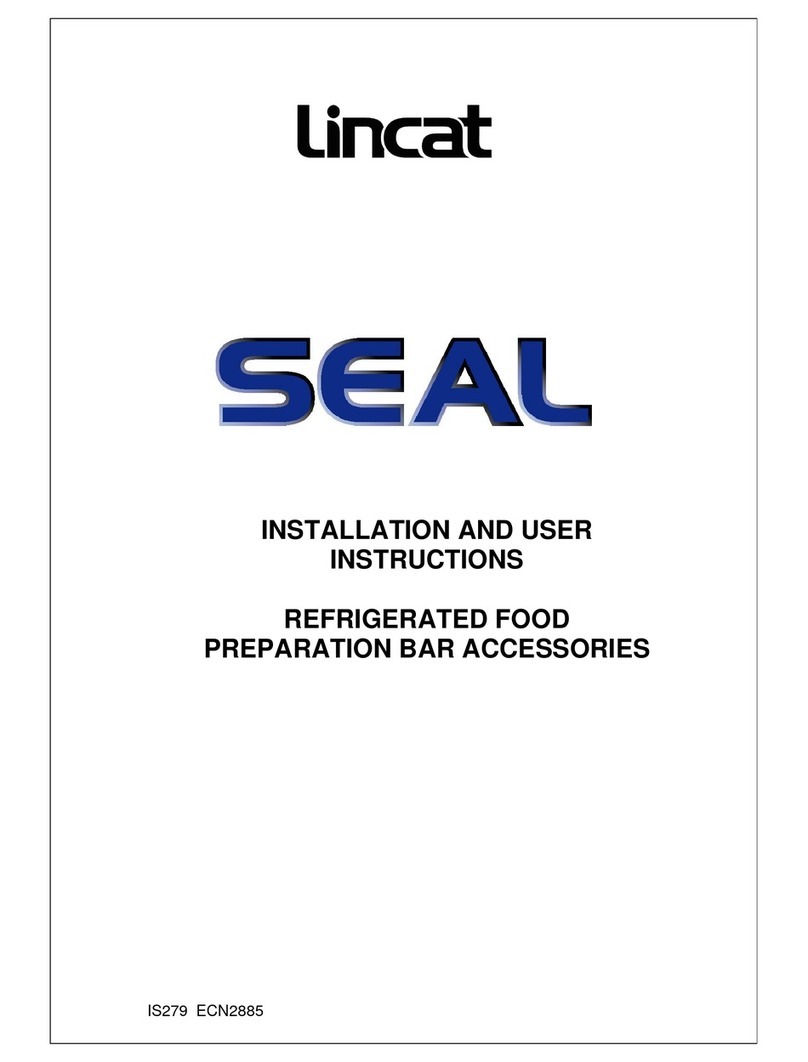
Lincat
Lincat SEAL PBG5 Guide
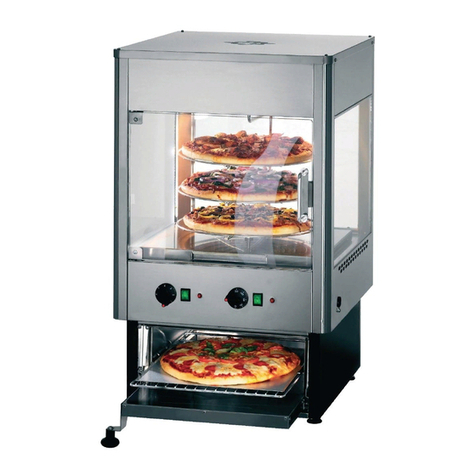
Lincat
Lincat UM50 Owner's manual
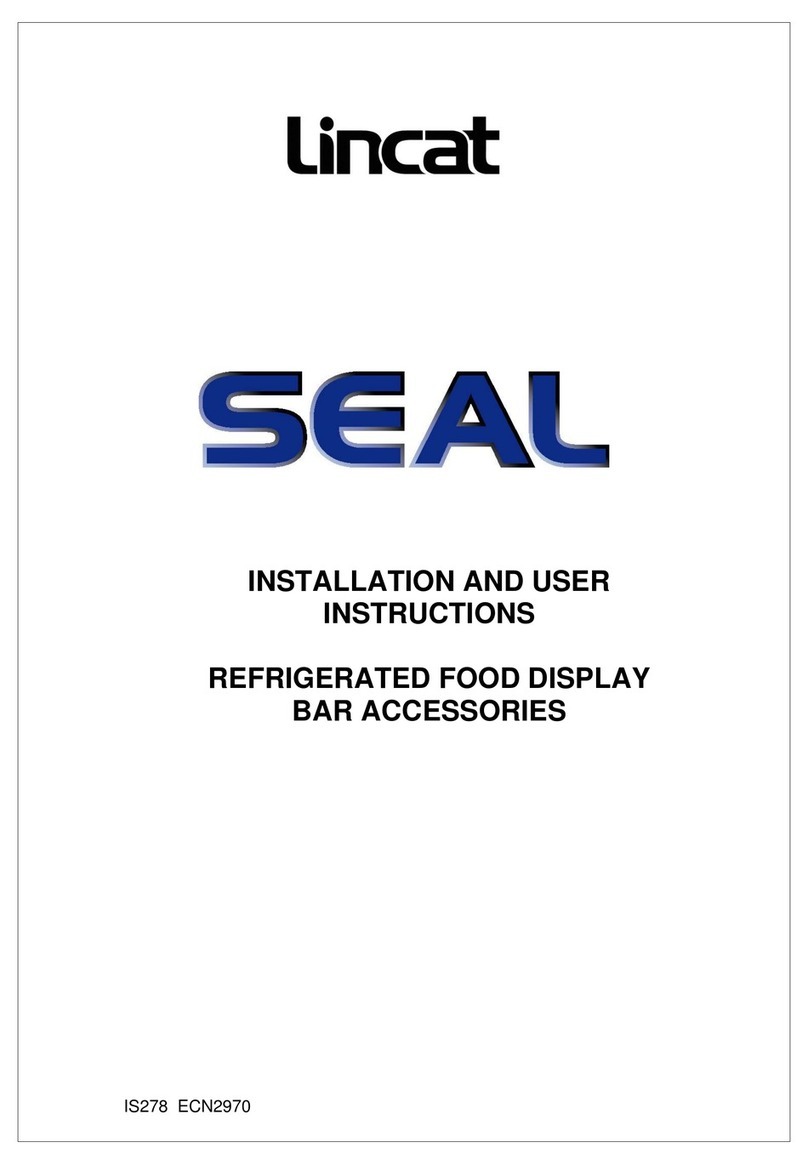
Lincat
Lincat Seal SSG5 Guide
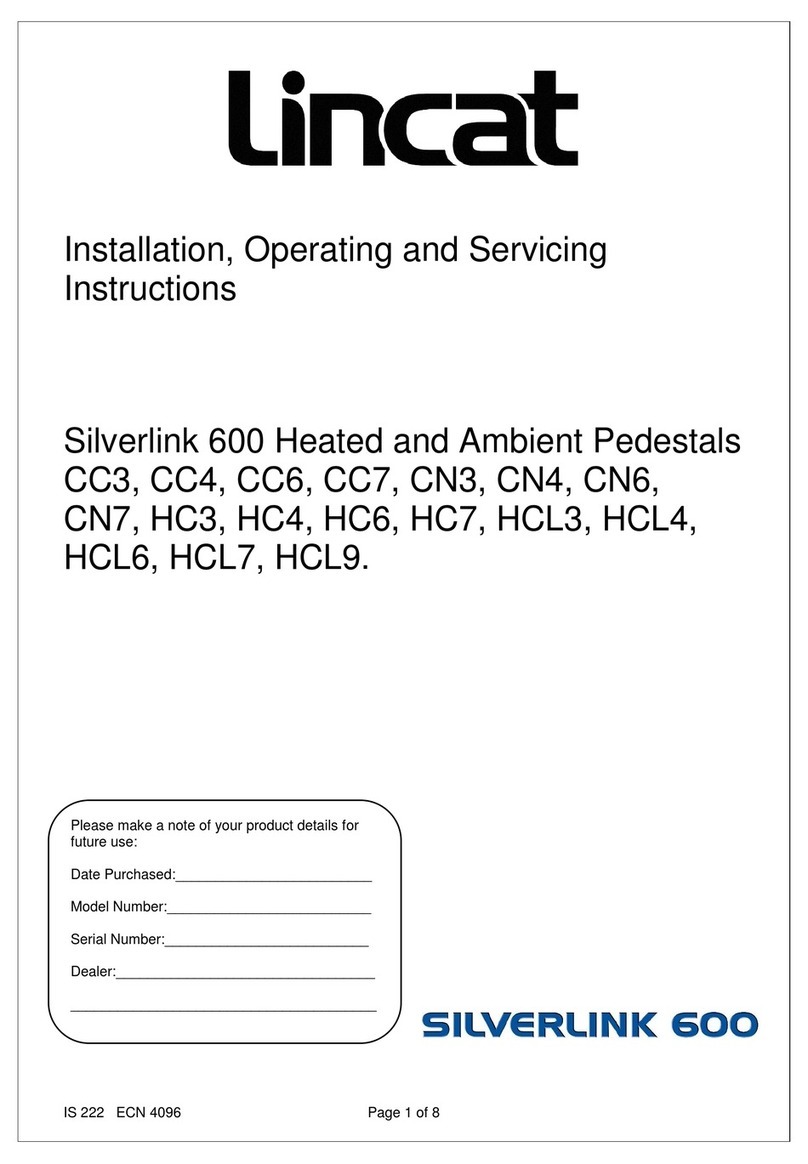
Lincat
Lincat Silverlink 600 Series Owner's manual
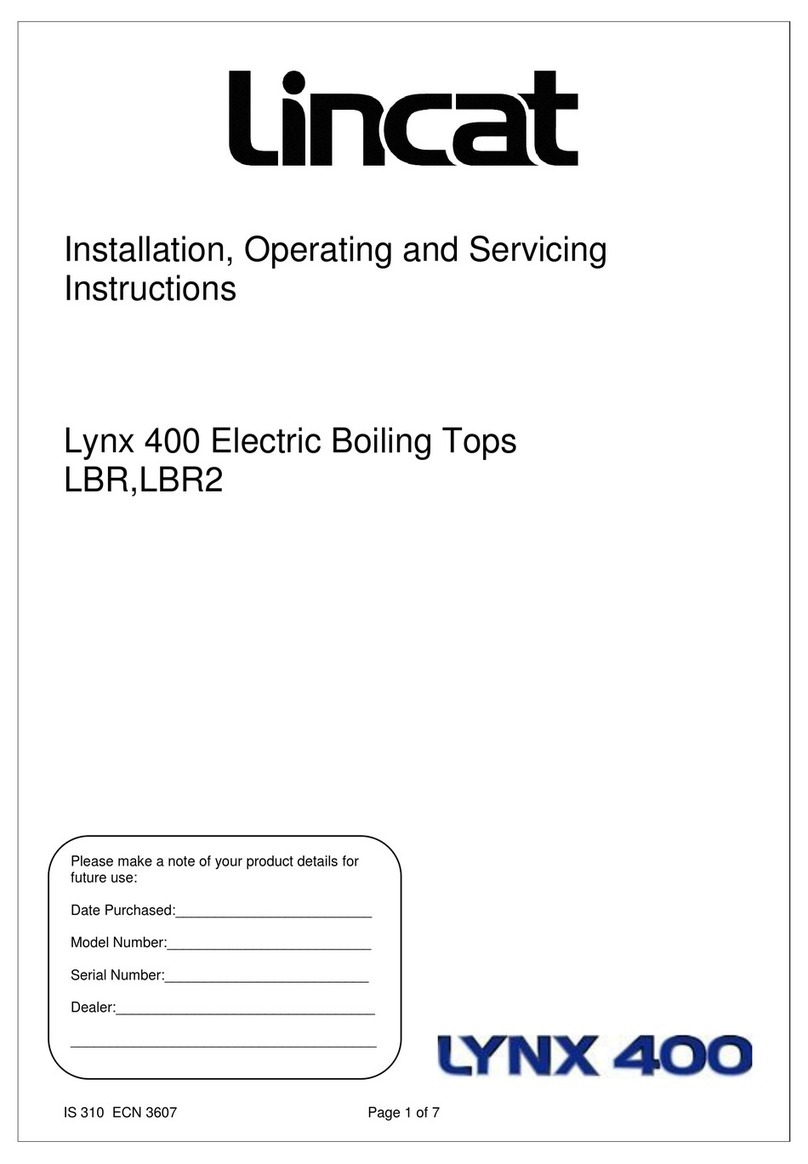
Lincat
Lincat Lynx 400 LBR User manual
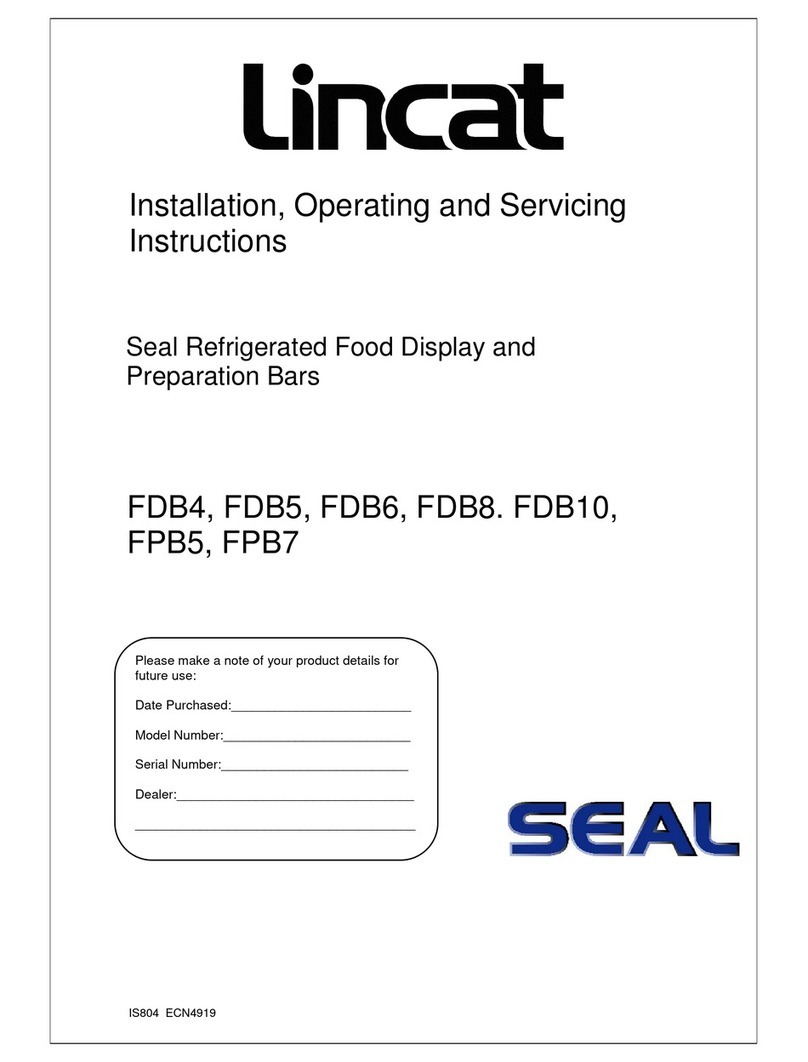
Lincat
Lincat FDB4 User guide
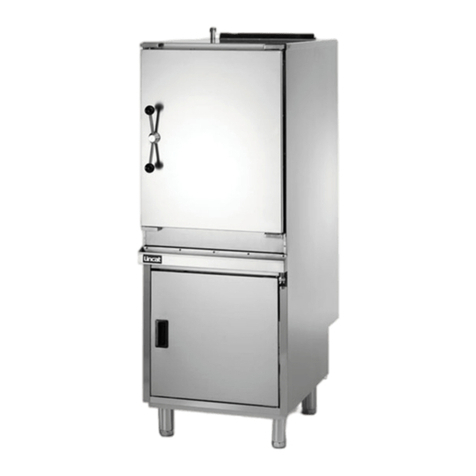
Lincat
Lincat Opus 700 Series User guide
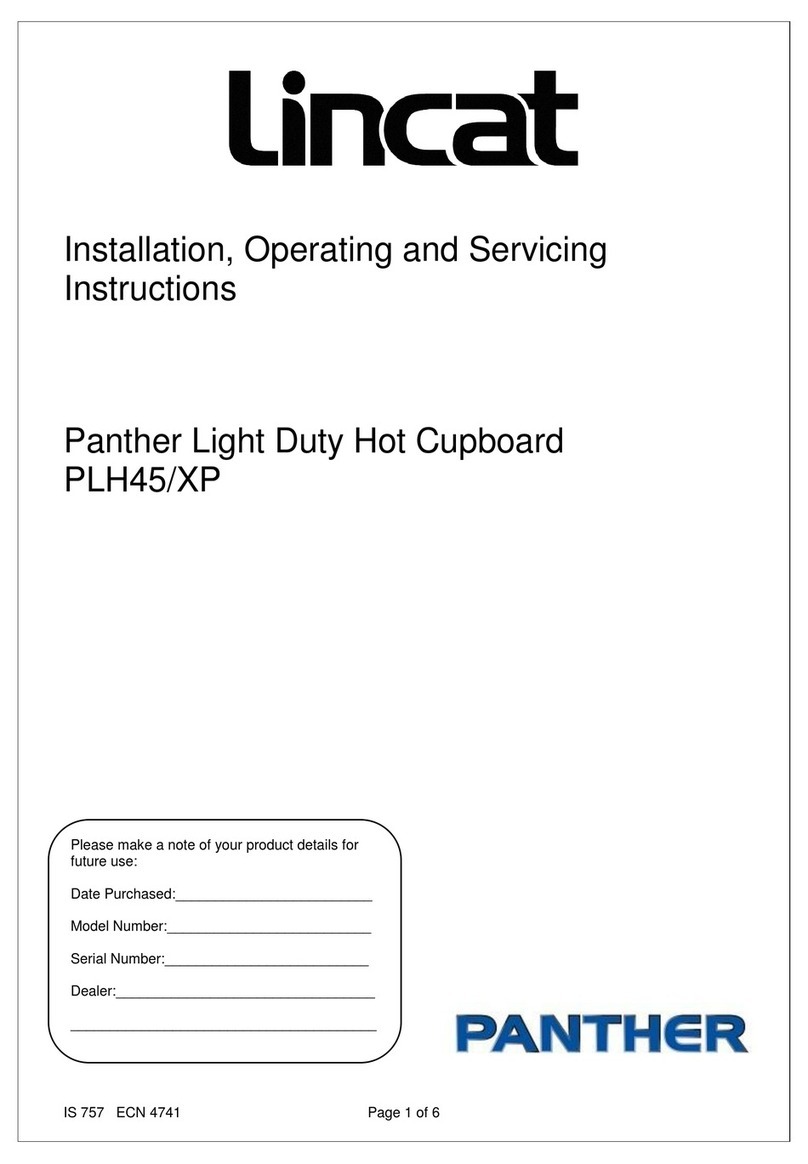
Lincat
Lincat Panther PLH45/XP Owner's manual

Lincat
Lincat Opus 700 Series Manual
Popular Commercial Food Equipment manuals by other brands
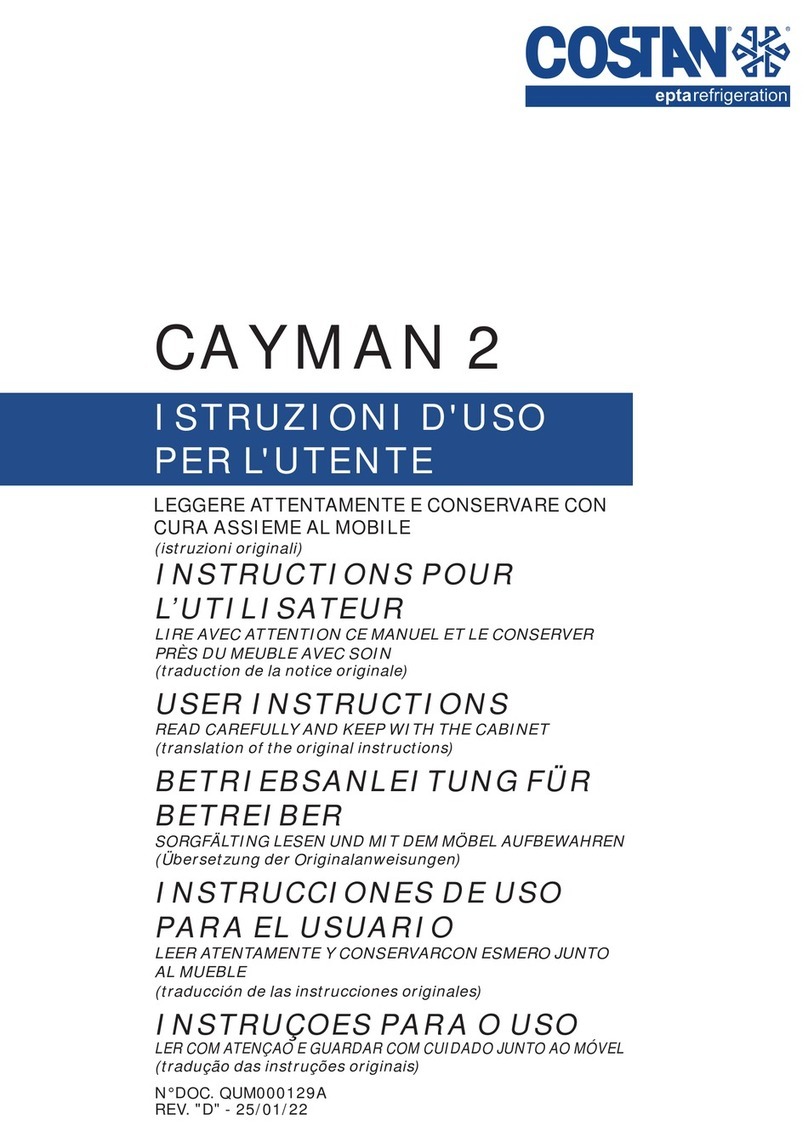
Costan
Costan CAYMAN 2 User instructions
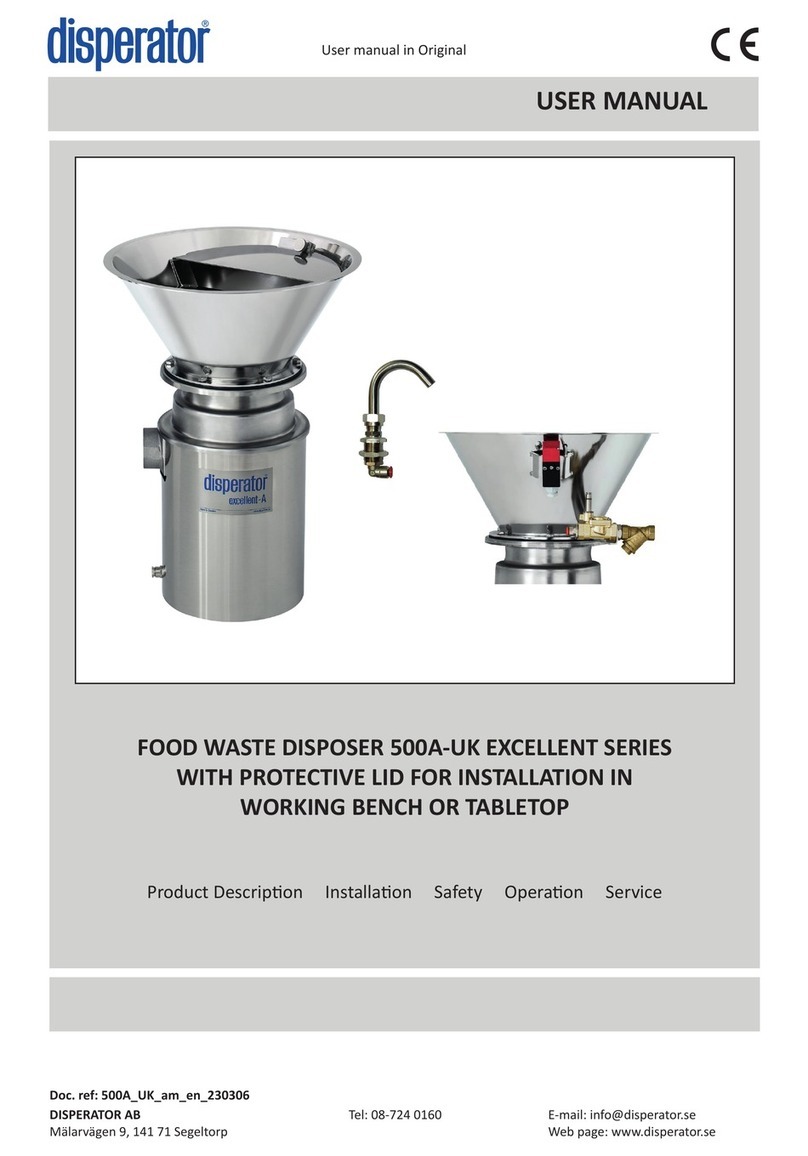
disperator
disperator 500A-UK user manual
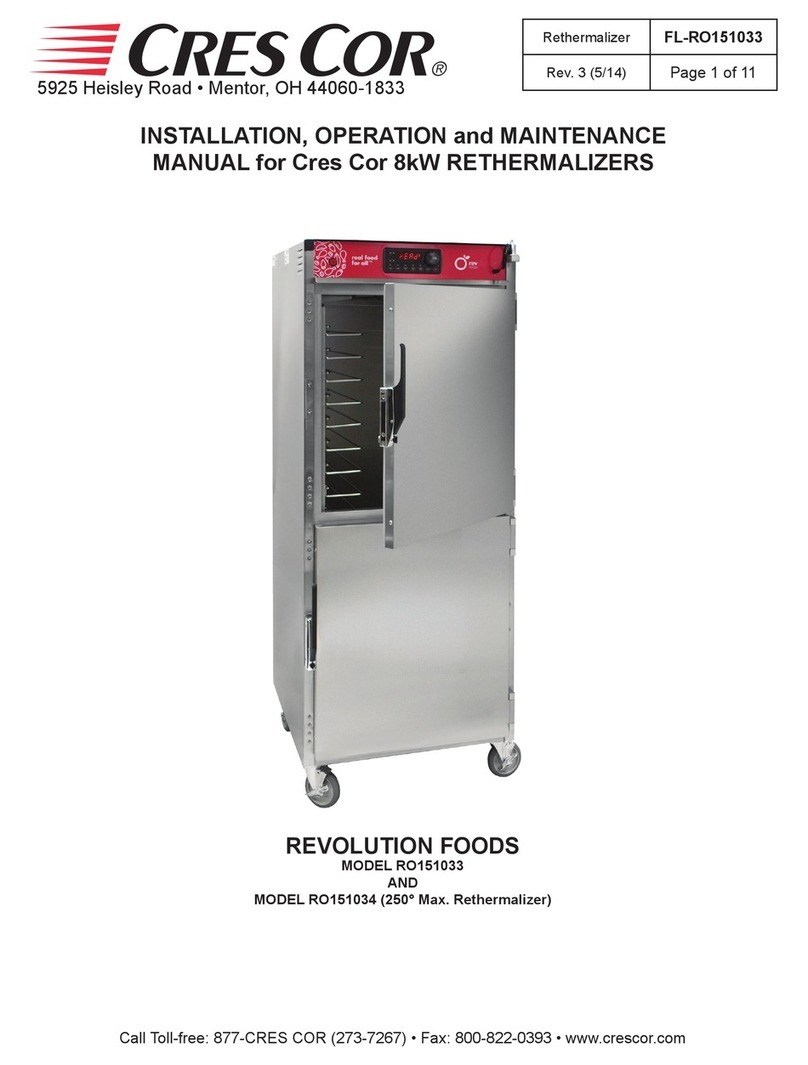
Cres Cor
Cres Cor RO151033 Installation, operation and maintenance manual
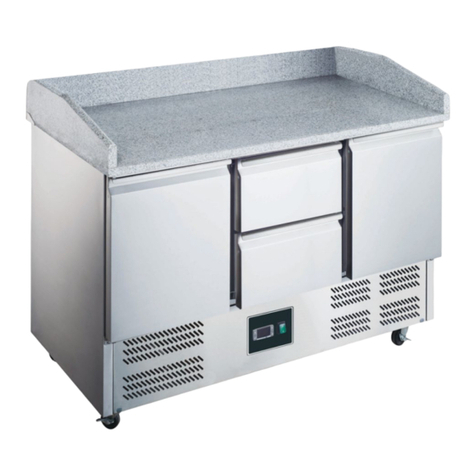
saro
saro ES 903 PZ 2/2 operating instructions

CARTER-HOFFMANN
CARTER-HOFFMANN PUCH-13 Operator's manual
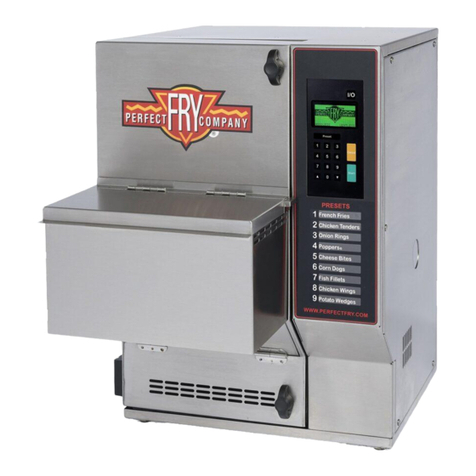
PERFECT FRY COMPANY
PERFECT FRY COMPANY DSA720 manual
